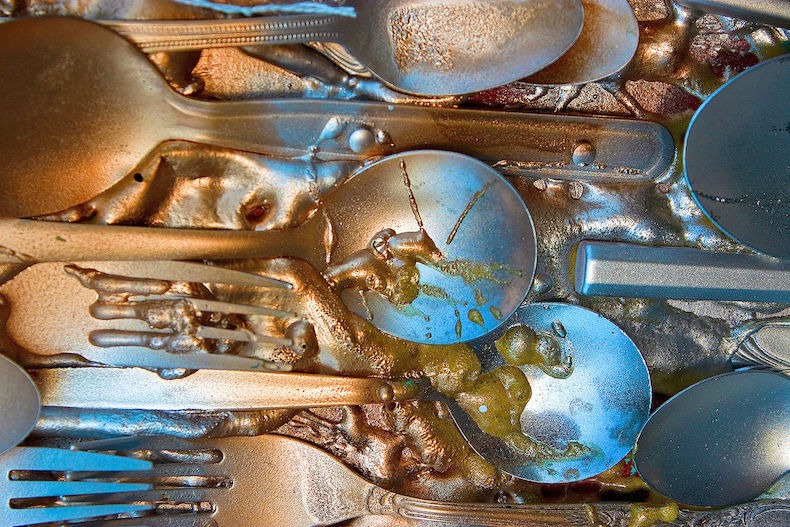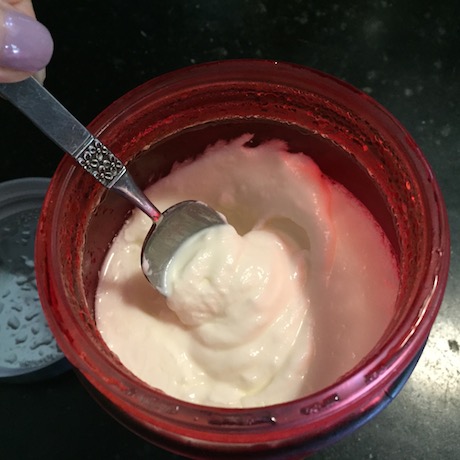 Recently, I’ve been making my own yogurt.
Recently, I’ve been making my own yogurt.
I’m on one of those annoyingly limited diets, trying to get my messed-up gut to cooperate. I can’t have many of the things I love. Noodles. Huge pieces of bread slathered with butter (and then one more piece even though it’s going to spoil my dinner). Cereal—not even oatmeal, so Captain Crunch is definitely out of the question. Muffins with Skittles on top (or without). Anything with flour. Milky things. Feta cheese. That sweet-tart powder that comes in a pouch with a little white candy stick that you lick and dip. Rice. ‘Taters. Chocolate. I can use a little honey if I need sweetener, and I can put almond milk in my coffee. (Lesson: No honey in coffee. Terrible.) Almost all fruits and veggies are fine, as are meat and fish and hard cheese, plus most nuts. And bone broth. I’m supposed to make and eat bone broth. (It’s made with chicken or beef bones, you sicko.)
But I’m already pretty tired of the “legal” foods. I constantly want to break the rules. Because my sweet tooth is the size of my head.
I’m trying to be good. And in order to comply with the rules, if I want yogurt, I have to make it myself. And I want yogurt. Sweetened with honey or fruit, it’s as close to pudding as I’m going to get. (Note to self: Get tee shirt made that reads Fruit on the Bottom.)
Yogurt is the product of the acidic fermentation of milk. So it’s basically an altered form of milk containing waste products of the fermentation process. That doesn’t sound very appetizing, but hey, people eat head cheese.
Here’s how one website explains the what happens as milk is transformed into yogurt.
…The lactose in the milk is converted to lactic acid, which lowers the pH. When pH drops below pH 5, micelles of caseins, a hydrophobic protein, loses its tertiary structure due to the protonation of its amino acid residues. The denatured protein reassembles by interacting with other hydrophobic molecules, and this intermolecular interaction of caseins creates a structure that allows for the semisolid texture of yogurt….
There’s more. Isn’t science fun?
Yogurt production begins with the breakdown of lactose into glucose and galactose, a process catalyzed by β-galactosidase. The glucose produced from this catabolic step then enters glycolysis, producing pyruvate. It has been proposed that yogurt bacteria utilize the Embden-Meyerhof-Parnas pathway of glycolysis. Pyruvate then enters lactate fermentation, also known as homolactic fermentation, as it produces only lactic acid molecules….
And so on.
As a science writer I should take that info and distill it down and turn it into beautiful and clear prose. Instead, let’s keep it simple and get right to the fun part, the microbes. From my extensive experience making two batches of yogurt, I’ve come to appreciate that those “live and active cultures” listed on the Yoplait cup are essential. They’re the bacteria that, first of all, make yogurt therapeutic in GI-compromised people. But also they break down lactose (a sugar) into smaller sugars that are easier to digest. Regular old yogurt gets incubated for about six hours, but if you are avoiding lactose, you can’t be in such a rush. Bacteria need time to work their magic. Twenty-four hours, to be exact. If you can wait that long before yanking off the lid to see what’s going on in there, you’ll have lactose-free yogurt! Thanks, live and active cultures!
But the best part about making yogurt (other than eating said yogurt) is seeing something go into a container as one thing and come out as another. Transformation. The milk reinvents itself, ending up where it started (cold, edible) but as something fresh and new. All you’ve done is taken that cold milk, heated it, cooled it down, added the live cultures, incubated, then made it cold again. And when you open the jar and dip in your spoon, what comes out is a creamy white loveliness that looks less sour-milk product and more something you’d use to frost a cake. (Except I can’t have cake.)
I’ve come to realize that what I’m doing to milk is what I’m trying to do to my gut. I’m changing my inputs, my process, the way I treat myself, and hoping to see a major change in output. I’m aiming for complete transformation, a full gastrointestinal makeover. Now, there’s an idea for a reality show. Extreme Makeover: Bowel Edition.
Interestingly, a lot of doctors I’ve seen (and I’ve seen plenty) don’t think diet has much or anything to do with autoimmune gut diseases. But as I’ve written in other posts, I have a desperate need to take control of my health, and there are only so many things an old girl with faulty plumbing can try. A lot of people swear they’ve cured what ails them through diet alone. And the diets they’ve designed are better for us than our usual menus, regardless of intestinal state: no added sugar, no processed food, no hard-to-digest grains, no lactose-heavy dairies, no foods thought to encourage inflammation.
In autoimmune diseases, after all, inflammation is the enemy. One must do what one can to remain the opposite of inflamed, which means constantly trying to douse an internal fire. I eat nearly constantly. Why wouldn’t food be part of my arsenal?
It may seem a small thing. But having the power, and the patience, to transform milk into soothing, microbe-rich yogurt that goes down smooth as a good mousse gives me, briefly, the sense that I can extinguish my illness on my own. And when your body is forever at war with itself, every small weapon makes a difference. Even one on the end of a spoon.
Top photo: psyberartist (forks and spoons Uploaded by russavia) [CC BY 2.0 (http://creativecommons.org/licenses/by/2.0)], via Wikimedia Commons
Other photos are the author’s.
Awesome metal yogurt bowl a gift from author’s brother from some town in Germany. Or maybe New York.
Yogurt hard science came from here: https://microbewiki.kenyon.edu/index.php/The_Role_of_Bacteria_in_the_Health_Potential_of_Yogurt

